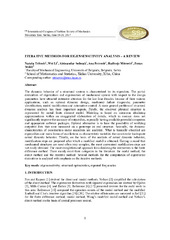Приказ основних података о документу
Iterative methods for eigensesnitivity analysis-a review
| dc.creator | Trišović, Nataša | |
| dc.creator | Li, Wei | |
| dc.creator | Sedmak, Aleksandar | |
| dc.creator | Petrović, Ana | |
| dc.creator | Mitrović, Radivoje | |
| dc.creator | Stokić, Zoran | |
| dc.date.accessioned | 2023-03-13T12:50:30Z | |
| dc.date.available | 2023-03-13T12:50:30Z | |
| dc.date.issued | 2017 | |
| dc.identifier.uri | https://machinery.mas.bg.ac.rs/handle/123456789/5985 | |
| dc.description.abstract | The dynamic behavior of a structural system is characterized by its eigendata. The partial derivatives of eigenvalues and eigenvectors of mechanical system with respect to the design parameters have attracted extensive attention for the last four decades because of their various applications, such as optimal dynamic design, machinery failure diagnostic, parameter identification, model modification and automative control. A more general problem of structural dynamic analysis has three important aspects. Firstly, the observed physical structure is represented by initial finite element model. Modeling is based on numerous idealizing approximations within an exaggerated elaboration of details, which in essence does not significantly improve the accuracy of output data, especially having available powerful computers and appropriate software packages. Optimal alternative is to have the possibility of verifying outputted data that were measured on a prototype or real structure. Secondly, the dynamic characteristics of construction under reanalysis are analyzed. What is basically observed are eigenvalues and main forms of oscillations as characteristic variables that can invoke inadequate actual dynamic behavior. Thirdly, on the basis of the analysis of actual dynamic behavior, modification steps are proposed after which a modified model is obtained. Having in mind that mechanical structures are most often very complex, the most convenient modification steps are not easily obtained. The most straightforward approach for calculating the derivatives is the finite difference method. There mainly exist three categories in the literature: the modal method, the direct method and the iterative method. Several methods for the computation of eigenvector derivatives is analyzed with emphasis on the iterative methods. | sr |
| dc.language.iso | en | sr |
| dc.relation | info:eu-repo/grantAgreement/MESTD/Technological Development (TD or TR)/35040/RS// | sr |
| dc.relation | info:eu-repo/grantAgreement/MESTD/Technological Development (TD or TR)/35011/RS// | sr |
| dc.rights | openAccess | sr |
| dc.rights.uri | https://creativecommons.org/licenses/by-nc-nd/4.0/ | |
| dc.source | Proceedings of the 6th International Congress of Serbian Society of Mechanics | sr |
| dc.subject | eigensensitivity | sr |
| dc.subject | structural optimization | sr |
| dc.subject | repeated frequencies | sr |
| dc.title | Iterative methods for eigensesnitivity analysis-a review | sr |
| dc.type | conferenceObject | sr |
| dc.rights.license | BY-NC-ND | sr |
| dc.citation.issue | S6c | |
| dc.citation.rank | M33 | |
| dc.identifier.fulltext | http://machinery.mas.bg.ac.rs/bitstream/id/14857/bitstream_14857.pdf | |
| dc.identifier.rcub | https://hdl.handle.net/21.15107/rcub_machinery_5985 | |
| dc.type.version | publishedVersion | sr |


